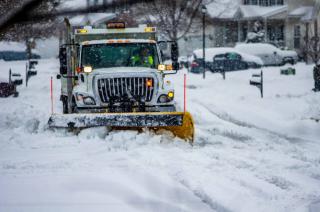Winter Weather Procedures

We live in Kansas, which means our winters can swing wildly from flurry to blizzard and back again. Because of the unpredictability of winter weather, the decision to initiate snow and ice removal operations is based on a variety of factors such as actual snow accumulation (or expected accumulation), icy conditions which affect travel, and time of snowfall in relation to traffic volumes. The use of weather reports from the National Weather Service, reviews of local television satellite storm tracking, and existing road condition reports are all used to determine the appropriate scope of operations. No two snowfalls are the same! Each winter event will vary in size and complexity and, while our Public Works and other snow removal crews always strive to work as efficiently as possible, it's understandable that there will be complaints or requests for additional services. Know that we are operating as efficiently as we can while also being considerate of our crews' safety and other critical obligations. If, after 24 hours, you feel that crews may have inadvertently missed your area, please call Public Works at (913) 755-4525 -OR- submit a report through TextMyGov by texting the keyword "SNOW REMOVAL" to (913) 557-8777 and following the prompts.
Observant, proactive homeowners help city crews clean snow and ice off our streets more efficiently by observing the following tips:
- Stay off the roads, if possible. The fewer vehicles on the road, the faster we can get them cleared. When cars are parked on the street during and after a snow storm, it prevents snow plow drivers from properly clearing the roads. It also increases the possibility of cars being buried by windrows of snow when the plows go by.
- Wait until plows have made at least one clear path before driving on a street.
- Do not park on primary city side streets.
- Do not park within a cul-de-sac. Due to the size of the snow plow trucks, City crews are unable to safely remove snow from culs-de-sac where vehicles are parked within the circle. One parked vehicle within a cul-de-sac will prevent that area from being plowed and must be removed before the plow truck can return to the area.
- Park your vehicle in your driveway and do not allow it to hang into the street.
- Driveways may be blocked during the snow removal process. Avoid placing snow from your driveway back into the street. We're often asked why snow plow drivers push snow into a driveway after the homeowner has already shoveled the driveway. The reality is that this is unavoidable. To help reduce the appearance of windrows, pile snow on the left side of your driveway (facing your home), and shovel an inlet on the right side. Dumping snow into the street is prohibited.
- Remove portable basketball goals or other structures from the street in order to avoid damage to the truck or portable structures.
- Stay at least 50 feet from the rear of a plow truck so the driver can see you. If you can't see the driver in his mirrors, he can't see you.
If, after 24 hours, you feel that crews may have inadvertently missed your area, please call Public Works at (913) 755-4525 -OR- submit a report through TextMyGov by texting the keyword "SNOW REMOVAL" to (913) 557-8777 and following the prompts.
The City operates three trucks equipped with snow plows and spreaders. There are four snow removal routes throughout the City, two that focus on main thoroughfares, and two that focus on residential streets. Our highest priority is ensuring residents and motorists traveling through Osawatomie are safe. But we understand you also need to travel the roads in a timely manner. To ensure the most number of people are able to utilize the roads, we plow them in priority order. Streets are prioritized by terrain, visibility and amount of traffic. Primary streets receive different service levels than residential streets. Primary streets often carry higher traffic volumes and should be cleared first so that residential traffic can safely move about once out of their neighborhood.
Primary Streets: Roads such as Main St, 6th Ave, Parker Ave west of 12th St, school access streets, etc. are considered arterial roads and receive first priority in plowing. This enables emergency service providers such as fire, ambulance and police safe access.
Residential Streets: Neighborhood streets are given second priority in plowing due to the smaller number of vehicles traveling on them. Public Works crews begin focusing on residential streets after snowfall stops and after other priority streets are treated and cleared.
